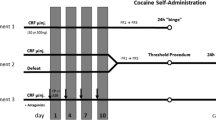Abstract
Background: An essential feature of cocaine addiction is the breakdown to control or regulate drug intake. Objective: The present studies aimed to examine the transition from regulated intravenous cocaine reinforcement to a more unpredictable, chaotic pattern of cocaine self-administration in rats that were given continuous access to the drug. Autonomic activity was continuously monitored via biotelemetry senders for heart-rate and core temperature before, during and after the cocaine ”binges”, in an attempt to characterize the breakdown of homeostatic regulation. Methods: After Long-Evans rats were fitted with intravenous catheters and intraperitoneal telemetry senders, they acquired cocaine self-administration with each fifth lever press being reinforced by a 0.25 mg cocaine infusion. Rats self-administered 15 cocaine infusions daily at stable rates for ca. 2–3 weeks, when continuous access periods (”binges”) of 26 and 72 h were scheduled, with a 3-week cocaine-free period between and following the two ”binges”. Results: A distinctive pattern of cocaine self-administration emerged during the ”binges” that consisted of (1) an initial loading phase, (2) stable, predictable inter-infusion intervals for up to 8–10 h, termed ”regulatory phase”, (3) increased variability in inter-fusion intervals, mostly beginning at 22–24 h of continuous access. During the first half of the 72-h ”binge”, the autonomic activities remained elevated, showed a greatly constrained variability, and the characteristic circadian rhythmicity was substantially decreased. The average cocaine intake (6.8±0.5 mg/kg per hour) during the ”regulatory” phase did not change during the subsequent phases. Following the 72-h ”binge”, the amplitude of autonomic circadian rhythms remained attenuated for more than 2 weeks. In a separate set of animals, the dose effect of inter-infusion intervals following the self-administered infusion was similar during a variable dose protocol, scheduled in an early and a late phase of a 30-h long ”binge”. Conclusions: The homeostatic dysregulation during the ”binge” as evidenced by the diminished capacity of autonomic functions to vary is accompanied by emerging irregularities in the pattern of cocaine self-administration.
Similar content being viewed by others
Author information
Authors and Affiliations
Additional information
Received: 1 June 1999 / Final version: 11 September 1999
Rights and permissions
About this article
Cite this article
Tornatzky, W., Miczek, K. Cocaine self-administration ”binges”: transition from behavioral and autonomic regulation toward homeostatic dysregulation in rats. Psychopharmacology 148, 289–298 (2000). https://doi.org/10.1007/s002130050053
Issue Date:
DOI: https://doi.org/10.1007/s002130050053




